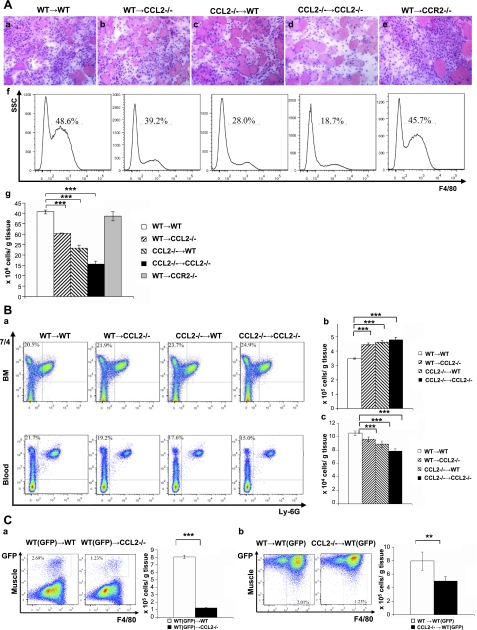Figure 4.
CCL2 expression by bone marrow cells, circulating monocytes, and injured muscle resident tissue cells was required for recruiting MOs/MPs from bone marrow to blood and from blood to injured muscles. A) H&E staining showed that the inflammatory infiltrates at d 3 were markedly reduced in Ccl2−/− → Ccl2−/− bone marrow chimeras (d) and partially reduced in Wt → Ccl2−/− (b) and Ccl2−/− → Wt (c) chimeras as compared with Wt → Wt chimeras (a). Flow cytometry showed reduced F4/80+ MPs in injured muscles at d 3 in Ccl2−/− →Ccl2−/−, Wt → Ccl2−/−, and Ccl2−/− → Wt chimeras as compared with Wt → Wt chimeras (f, g). Wt → Ccr2−/− chimeras showed an inflammatory response (e) and intramuscular F4/80+ MPs (f, g) similar to those in Wt → Wt chimeras. B) At d 3 postinjury, the percentage (a) and numbers (b, c) of 7/4+Ly-6G− MOs/MPs were increased in bone marrow and reduced in blood in Ccl2−/− → Ccl2−/−, Wt → Ccl2−/−, and Ccl2−/− → Wt chimeras as compared with Wt → Wt chimeras. C) a) Bone marrow monocyte transfer showed that the number of GFP+ monocytes recruited into wild-type injured muscles at d 3 was significantly higher than that recruited into Ccl2−/− injured muscles. b). Number of wild-type GFP− monocytes recruited into wild-type injured muscles at d 3 was significantly higher than that of Ccl2−/− GFP− monocytes. n = 5–7 mice/group/experiment. **P < 0.01; ***P < 0.001.

